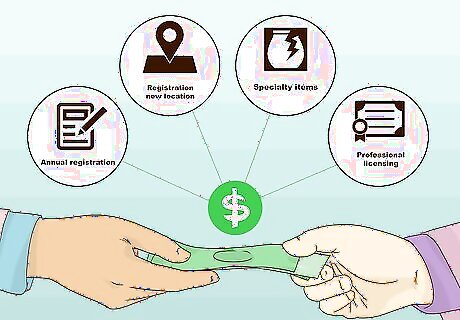
views
Getting Your Business Off the Ground

Choose a niche and type of store for your shop. Pick something that you’re both knowledgeable and passionate about. Try researching other businesses in the area for gaps in the market. You won’t want to open up an organic skin-care shop if there are others nearby. This is also the time to decide what type of shop you want to create in terms of sheer size. Do some research on rent prices in your area before setting in stone any one type of shop.

Write a short business plan. If you want to write a business plan, it’s usually best to keep it simple. That being said, even a basic business plan has quite a few steps. Don’t be afraid to ask for help with this one! A few key items to include are: Who your manufacturers and suppliers are and what their rates for key products are Your overhead costs (inventory, salaries, advertising, legal fees, utilities, incidentals) Financial projections regarding when your store should break even (This is hugely important if you’re looking for a bank loan!) Advertising strategies A bulleted basic action plan to achieve your goals

Figure out your budget. Try to keep your costs as low as possible at the beginning and be realistic about your numbers. Try to account for incidentals as well; unexpected costs always seem to arise in your first few months! A few key parts to look at for your shop include: Your supplier’s product and delivery costs Advertising costs Utilities and rent costs Staff salaries Any legal or permit fees for your area

Research licensing and fees. Each municipality will differ with their process for opening up a small business. You’ll want to do thorough research about your city, county, and state before actually starting your business. A few items to expect include: Annual registration fees Registration fees for any new location Specialty items fees (some states require extra licenses when selling certain items, such as perishables) Professional licensing fees

Pick a legal entity. This will take a little bit of research on your end, but many small businesses start out as a sole-proprietor. This usually means fewer fees and less paperwork. There are a few different options here, but be sure to do plenty of research before choosing: Sole Proprietorship - less fees and paperwork, but more personal risk at stake Partnership - more resources for capital and decision making, but can delay processes Limited Liability Company (LLC) - most flexibility for the structure of the business, but more comprehensive paperwork and fees Corporation/S-Corporation - less personal liability, but more government regulation

Pick a location with high foot traffic near other beauty stores. Whether it’s a mall, a shopping center, or just a popular neighborhood, you’ll want to be sure to pick a location that has a high amount of pedestrians and other beauty shops nearby. You don’t want your customers to have to make a special trip just to get to your shop!
Acquiring the Right Equipment

Do plenty of research on beauty product suppliers. There are a ton out there with similar prices and reviews. Make sure to do ample research before agreeing to partner with any one business. Check plenty of reviews online and don’t be afraid to flood them with questions. Remember: the products are the foundation of your business!

Ask for samples from a few different retailers. Once you’ve narrowed down your choice of suppliers, try asking for some samples of their products. Most businesses will offer these for free in hopes of partnering with you. Make sure they deliver a high quality product. Try testing them out yourself or comparing them to other products you’re familiar with. Ask friends or business contacts their thoughts on the products as well. Their logistics and customer service should also be solid in order to avoid any future headaches!

Place your first order. Focus on ordering larger quantities of popular and widely used products at the beginning. Wait on ordering a ton of the riskier items until you’re a little more comfortable. Researching beauty publications are a good way to get an idea of what sells and what doesn’t.

Furnish your store with lights, mirrors, and shelves. Lights and mirrors are super important so your customers will be able to try various products on before purchasing. Be sure to decide on a shelving arrangement as well! You can have shelves line the perimeter, stand alone in the middle of the shop, or both.

Properly store your inventory. Storage requirements may differ from product to product, but most beauty items require room temperature storage away from any moisture, smoke, and direct sunlight. Make sure your location has enough storage space to suffice!

Decide on your ambience. Find a way to make your store unique. You’ll want your customers to feel relaxed so they don’t feel rushed when they’re inside. The longer your clients stay in your store and shop, the more products you’ll sell. A couple ideas for a feel to get you started could be: Fancy, high-end cosmetics with posh displays and decorations Independent, organic shop with rustic decor and minimalist displays

Place popular items near the front of the shop. These will be what draw pedestrians in. Many clients are fairly loyal to brands and specific products. Try to place big sellers near the front so they won’t have to wander aimlessly trying to find their favorite items.

Get creative with your displays. This is especially important in the beginning to separate yourself from other beauty shops and will help to draw in interested customers. This will vary heavily depending on your products and preferences, but a few fun ideas are: TVs running footage of models wearing and/or using your products Holiday centric displays Color coordinated displays with products shaping a larger image
Running a Successful Shop

Develop an online presence with social media accounts. Try to advertise on Facebook. Sponsored posts will allow you to specify your target market and reach out to those with interests in beauty supplies. Remember to make your social media presence unique and helpful. In order to use social media to market, boast consistent branding across all social media platforms by using the same logos and types of posts.

Reach out to local publications, blogs, and websites. Online write-ups are an easy way to get free marketing. Try shooting an email to your local newspaper or city magazine, letting them know about your new business. Do the same for beauty-specific blogs and websites. Most of these outlets are always looking for more content, so offer up yourself for an interview or featured article.

Purchase a point of sale software. Instead of a standard cash register, many small businesses these days are pivoting to running their sales through iPads. Most of these platforms also come with easy ways to track your different products and daily reports. While there are a ton of options out there, a few popular ones include: Revel Square Breadcrumb Lightspeed

Track your inventory regularly. This will help you make sure you never run out of popular products. Let the inventory and trends directly impact your next order from your supplier.



















Comments
0 comment